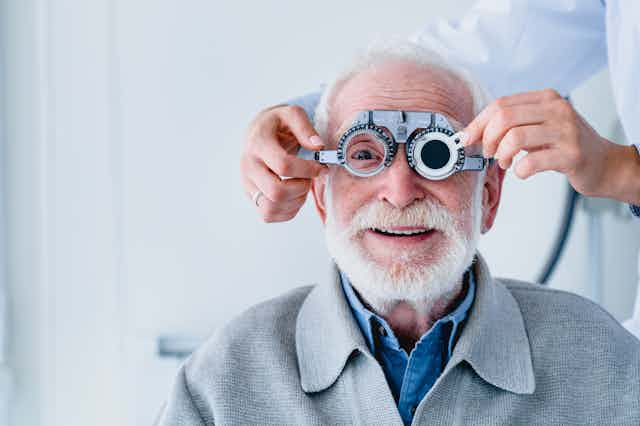The World Health Organization estimates that over 80% of all vision impairment around the world can be prevented and even cured. Reducing the risk of eye diseases involves adopting a combination of lifestyle changes, protective measures, and regular eye care. Here are six ways to look after your eyes in 2024.
1. Have regular eye tests
Many eye diseases don’t have symptoms – at least, initially. Glaucoma, for example, will cause irreversible damage to the eye if not picked up early enough as it damages the peripheral visual field to start with. People tend not to notice and merely compensate for this loss of peripheral vision by moving their heads more.
Eye disease linked to diabetes also causes irreversible damage to the eyes without much noticeable vision loss as it damages the small blood vessels in the eye.
Going for an eye test with a qualified optometrist will enable them to detect eye diseases and refer you to a specialist if needed. Early detection of changes in the eye due to diabetes will reduce the risk of blindness by 60-90%.
And a visit to the optometrist does not necessarily mean you have to fork out for expensive new glasses if your vision hasn’t changed. People in the UK qualify for free NHS eye tests if they are over 60 or under 18 years, have a family history of glaucoma, or receive certain state benefits.
2. Check your eyes at home
As most of us use both eyes at the same time, it can be difficult to know if one is not seeing so well. Try covering each eye every week and look at a number plate in the distance to make sure both eyes are seeing well.
Differences between the two eyes will affect your depth perception, which then ends up with you not being able to judge how far a person is when driving.
Age-related macular degeneration usually affects one eye earlier than the other. And the “wet” type – caused by tiny blood vessels at the back of the eye leaking fluid – needs to be treated as soon as possible to avoid any further damage.
Use graph paper held at a near distance, wearing near glasses if you need them, and if lines appear to be wavy or missing, seek an appointment with your optometrist.
3. Protect your eyes from mechanical and UV damage
Ultraviolet light can damage the macula, the most central and important part of the eye. Make sure you wear good quality sunglasses that block 100% of UVA and UVB rays to protect your eyes from harmful ultraviolet radiation.
If you are a DIY enthusiast, it’s really important to wear safety goggles. In the summer, gardening accidents, such as getting caught in the eye with a twig when pruning are quite frequent and can cause permanent damage.
Playing squash and other sports without adequate protection can also cause permanent damage. A squash ball is just a bit smaller than the orbit of the eye and this can cause a lot of damage to the soft tissues within the eye as the orbital wall cannot stop the ball’s entry into the eye.

4. Reduce digital eye strain
Excessive exposure to computers and smartphones can lead to eyestrain. While eyestrain does not normally cause permanent damage or affect your glasses prescription, it can be very uncomfortable.
Most people forget to blink when they are working on screens, and this leads to dry eyes. To reduce this discomfort, try consciously blinking more often during screen time.
It helps keep your eyes moist and reduces that tired, dry feeling. You can set a reminder on your phone for blinking exercises where you forcibly blink at least ten times every hour.
Regular breaks will not only give your eyes a rest but will also give your back a rest, too. Remember the 20-20-20 rule: every 20 minutes, take a 20-second break, and look at something 20 feet away.
5. Have a good diet
While many of us know that vitamin A from carrots is good for the eyes, our eyes need more than vitamin A to function healthily.
Vitamin C found in citrus fruits, strawberries, bell peppers and broccoli helps protect the eyes from oxidative damage as does vitamin E found in nuts, seeds, spinach and fortified cereals.
Green leafy vegetables have been shown to reduce the risk of macular damage, which is the leading cause of blindness in the elderly.
A healthy diet is also linked to good control of diabetes, and poor control of diabetes will lead to a much higher risk of blindness from diabetic-related eye disease.
6. Quit smoking and be more active
Smoking is a significant risk factor for most systemic diseases in the body including the eyes. Smoking increases the risk of macular degeneration and cataracts. Quitting can be tough, but your eyes will appreciate it in the long run.
Exercise is not only important for the rest of the body but also for the eyes. Outdoor activity is a significant protective factor against the progression of myopia (shortsightedness) in children.
Physical activity increases blood circulation to the eyes, which is essential for delivering oxygen and nutrients to the eyes and removing waste products. It has also been linked to reducing the risk of age-related macular degeneration, diabetic retinopathy and glaucoma.
Physical activity is also essential for controlling diabetes, which reduces the risk of blindness in patients with this condition. It is important to note that physical activity is not just about joining a gym. It can involve free activities, including brisk walking, which would be a wonderful opportunity to spend time with family and reduce the progression of myopia in our children.

